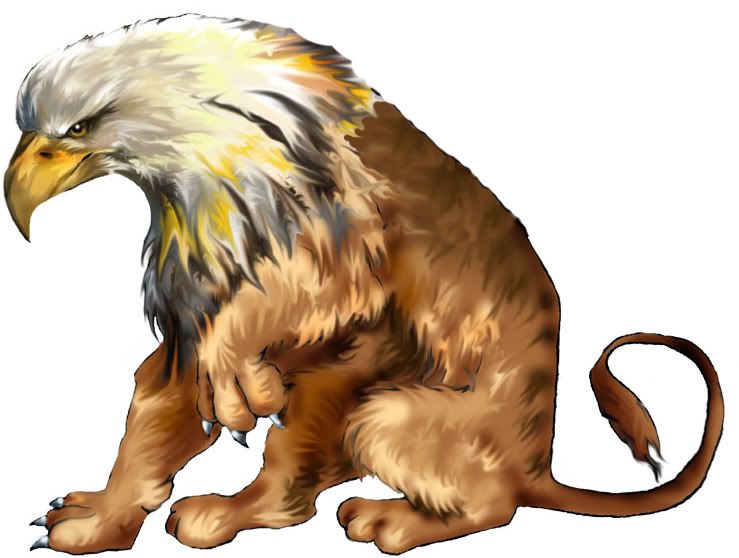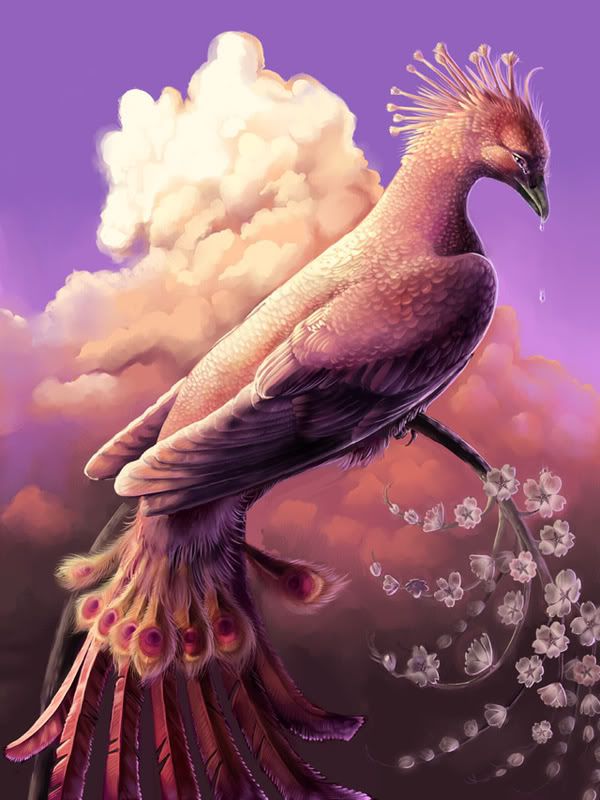|
|
Post by engelbert on Jan 15, 2008 16:27:10 GMT
In this thread you will find a list of all the various creatures and inhabitants of the Northern Land Mass.
|
|
|
|
Post by engelbert on Jan 15, 2008 23:03:03 GMT
The Griffin: (Also known as griffon or Gryphon) An incredible hunter, the griffons of Archidet are a recent discovery that had previously been thought of as beasts of legends. They live solely in the mountains North of Eshent-ur and so very few sightings had been recorded before the Elves decided to claim the lands as their own. They were known as creatures of myth; strange wild beasts that sailors would spot prowling the shores whilst circling the coasts of Eshent'ur. Because of their elusiveness and incredible hunting speed, sailors often mistook them for having wings. Griffins are half lion and half eagles; the true kings of the predator world. Their head and front limbs are those of an eagle whilst their back half is that of a lion. The front of the body is covered in beautiful white plumage though this plumage does not continue on as wings. They are very adapted for their carnivorous diet. With large razor-sharp talons and a serrated hooked beak similar to other raptor birds. They have two preferred methods of hunting; charging or pouncing from above. When pouncing, the Griffon will stalk its prey from above, before leaping down upon the hapless victim. The pounce, due to the Griffins weight, will often break its prey's spine and thereby kill the animal. Usually this time of hunting only occurs in mountainous terrain. When prowling the forest around its home, the griffon will opt for a charging attack. The griffin will, under the cover of foliage, creep up to its prey to within 20 yards before charging out to attack. The powerful hind legs of the griffon allow it to reach very high speeds. This power also allows the griffon to take very large prey such as horses or stags. Despite this, reports of griffin attacks are very rare. It is thought that they find noise caused by humanoids alarming or offputting while hunting, or perhaps they recognise humanoids as a threat and therefore avoid them. Griffin young are known as Cublets. A mix between lion cubs and eaglets (the immature young of eagles). Cublets are born from their mothers without feathers, but a pale downy fur on the eagle half. They are not hatched from eggs as some people have suggested. It is written that a Griffin egg was presented to the Lady Annette by King Ruskov as a gift and so won her heart. We now know this to be false and that the egg must have been from another animal. Either a misbirthed Dragon egg that was abandonned or the egg of a large sea serpant that had washed up on shore is the most likely source of the 'Griffin Egg'. Often mother griffin's will give birth to 2 or 3 cublets per season. Unfortunately very few survive to adulthood as large male griffin will prey upon cublets if they come across them. It is estimated that only 1 in every 15 cublets will reach adulthood. 
|
|
|
|
Post by engelbert on Jan 16, 2008 14:19:44 GMT
MoochuThe Moochu is a rare creature that lives in dense forest in warm conditions. They live primarily upon nectar from flowers and so it is important that they remain in highly floral areas. The Moochu is very timid and such is why it is rarely seen. There have been cases of some Moochu spotted in large Gardens that are close to forestland but this is only if the gardens are quiet and rarely visited. The Moochu is roughly the size of a fieldmouse. It has the head and wings of a hummingbird and whilst the rest is akin to the lower half of a mouse. Its head and wings are covered in bright turquoise-blue feathers like those of a Kingfisher. The Moochu also has a long narrow beak with which it can easily reach down into flowers to extract the sweet nectar. Though the body of these sweet looking creatures is mostly like a mouse, the front two paws are noticeably different. The toes are extended and more similar to a bird’s claw, the skin is also rougher. These adapted feet seem to provide excellent grip on stems and thin branches of plants whilst the animal feeds though. The fur of the Moochu is a blueish grey on its sides and back, though the stomach area is either a paler grey or white. Variations of this breed sometimes have a brightly coloured throat in red or orange feathers. The Moochu feeds by hovering slightly above flowers and dipping its beak into the flower. If possible, it will hold onto a branch for extra stability while it feeds. The Moochu also seems to use its long mouse tail for stability when in the air or moving through tree branches. It can be waved to and fro in the air to counterbalance any unequal weights or steady itself when turning/buffeted by winds. When not in flight, the tail is often wrapped around things for support. It is highly dextrous and can easily curl around things. Injured Moochu that are found will often wrap their slender tails around the fingers or thumb of people that pick them up. Moochu are known to live in the Feral Woods of the Centaur, the Children of Aliadore, Fallen Dragon Marsh (though only seen in summertime when the vineplants flower), The South of Eshent’ur and the NorthWest of the Woodland of the Betrothed. 
|
|
|
|
Post by engelbert on Jan 19, 2008 3:03:51 GMT
The PheonixA magestic bird rarely seen in the lands of Archidet; the Phoenix is said to bring good luck to any that lay their eyes upon it. The phoenix is quite a large bird, about the size of a goose. It has a long slender neck with a small, delicate head and a beak like that of a dove. Its tail is long and decorative similar to a peacocks. This grandeur is emphasised by the colour of the bird’s plumage. Rich crimson and orange, the Phoenix streams across the sky like a living comet. Many myths have emerged about the phoenix. The favourite one is that the tears from a phoenix have the power to heal all wounds. The second is that phoenix’s, upon death, burn to ashes and are reborn into the world as a chick. The second myth has been proved false thanks to careful tracking of these beautiful fowl. The phoenix does in fact lay a nest of eggs hidden in a place safe from predators shortly before it dies. These eggs are incredibly hardy and do not require incubation. So long as the temperature does not drop below 0 degrees celcius, the chicks will be able to hatch unharmed. Shortly fter laying the eggs, the female phoenix will self-combust. It is unknown how or indeed why, but it is recognised that this is the most common method of death for these noble creatures. Phoenix hatchlings are incredibly strong. Like butterflies they emerge fully formed and need only to dry out their wings in order to fly. A phoenix chick will often wait around the nest for 24 hours before becoming confident enough to take flight and make their own way in the world. As they are so small, they are only able to eat small fruit, berries and tiny insects for the first year of life. Once they are older they can live on a diet of berries, many different insects, small lizards, small frogs/toads and grain. Phoenix chicks look exactly like their parents but much smaller in size. A newly hatched chick can easily curl up in a human’s cupped hands. 
|
|